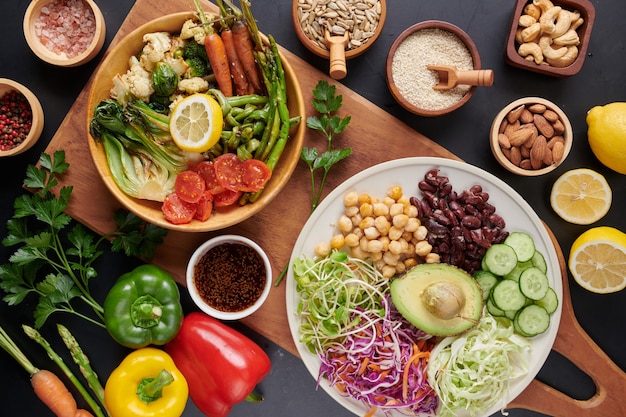Creating a healthy diet plan for kids is crucial, especially in the years of their growth. With the amount and variety of food out there, ensuring that your kids eat healthy can be quiet a task. A healthy diet plan for kids sets the base for substantial growth.
Eating a variety of foods keeps our meals interesting and flavorful. It’s also the key to a healthy and balanced diet because each food has a unique mix of nutrients—both macronutrients (carbohydrates, proteins and fats ) and micronutrients (vitamins and minerals).
We need to focus on all five food groups and plan a kid’s meals accordingly. There are a few points that need to be taken care while planning a meal , so that wholesome nutrition is provided to a child and the child readily accepts it with least resistance.
1. Foods rich in protein and energy are important for kids as the growth years require a little extra focus on it. The foods that are rich in protein are beans and peas, nuts, seeds, and other plant-based healthy protein options, as well as fish, eggs, and poultry. Limit red meat (beef, pork, lamb) and avoid processed meats as these have an extra dose of salt and preservatives which are not healthy.
Milk and other dairy products are a convenient source of calcium and vitamin D, but children with lactose intolerance, need to avoid cow and buffaloes milk and alternate options like A2 milk, soy milk, and almond milk should opt.
2. Creating a relaxed atmosphere during meals encourages eating.
3. Ensure that your kid eats the right amount from each food group for complete nutrition. More veggies and fruits and specially coloured veggies and fruits will help the child get all the right vitamins and minerals. Choose whole fruits or sliced fruits rather than fruit juices. Limit fruit juice to one small glass per day.
4. The other food group, which includes whole grain, forms 60% of our meal and so our very essential in a child’s plan. Whole grains, like whole wheat, brown rice, quinoa, and foods made with them, such as whole-grain pasta and 100% whole-wheat bread have a gentler effect on blood sugar and insulin than white rice, bread, pizza crust, pasta, and other refined grains.
5. It’s also important to remember that fat is a necessary part of our diet, and what matters most is the type of fat we eat.
Use healthy oils from plants like extra virgin olive, canola, corn, sunflower, and mustard oil in cooking vegetables, and at the table. Limit butter to occasional use.
6. Water should be the drink of choice with every meal and snack, as well as when we are active. Water is the best choice for quenching our thirst. It’s also sugar-free, and as easy to find as the nearest tap.
Limit juices to one small glass per day, and avoid sugary drinks like sodas, and fruit drinks, which provide a lot of calories and virtually no other nutrients. Over time, drinking sugary drinks can lead to weight gain and other problems.
7. Lastly an hour per day of any physical activity takes care of a child in addition to the right diet. Children and adolescents should aim for at least one hour of physical activity per day, and they don’t need fancy equipment or a gym. Activities for children such as playing tug-of-war, or having fun using playground equipment are good option.
Written by: Nutrionist Tanya Sahni

Author’s bio:
I am a nutritionist by profession and co-owner of a chain of wellness centres under the name of Health Zone in Lucknow. It’s been 16 years in the wellness industry. I am a postgraduate in Clinical Nutrition and Dietetics.




